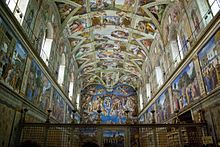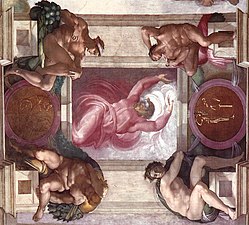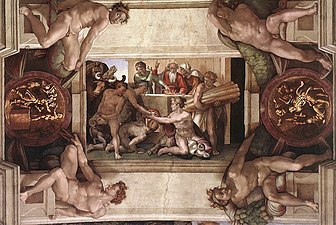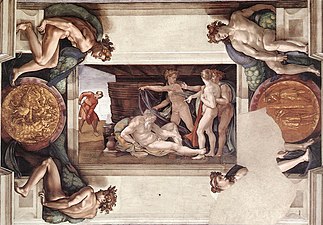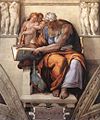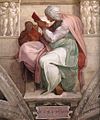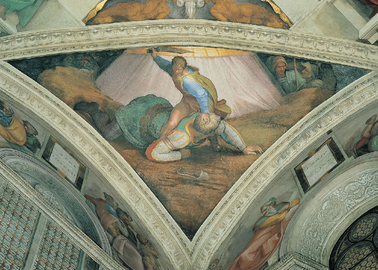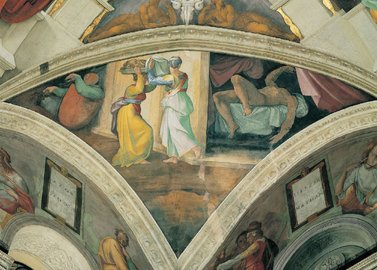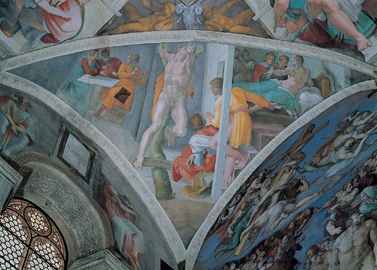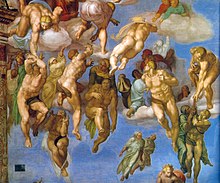Sistine Chapel
| Sistine Chapel | ||
|---|---|---|
 View of the Sistine Chapel of the dome of St. Peter's Basilica from |
||
| Data | ||
| place | Vatican city | |
| Construction year | 1475-1483 | |
| height | 21 m | |
| Floor space | 550 m² | |
| Coordinates | 41 ° 54 '10.7 " N , 12 ° 27' 15.8" E | |
|
|
||
The Sistine Chapel ( Italian Cappella Sistina ) is one of the chapels of the Apostolic Palace . It is the place where the conclave is held and houses some of the most famous paintings in the world. Its name refers to Pope Sixtus IV , under whom it was built between 1475 and 1483. The chapel was consecrated on August 15, 1483 . It is under the patronage of the Assumption of Mary into heaven .
It is located immediately north of St. Peter's Basilica and is connected to it via the Scala Regia and Sala Regia . For tourists, however, entry is only possible via the Vatican Museums .
architecture
The plans for the Sistine Chapel were made by Baccio Pontelli . The floor plan is rectangular. The building is 40.9 meters long, 13.4 meters wide and 20.7 meters high. The chapel is built in the proportions of the Temple of Solomon , its length is roughly twice the height and three times the width. The ceiling is a flat vaulted needle cap .
Frescoes
Mural
The murals show, respectively, to the east scenes from the life of Jesus and Moses and were of different painters of the Renaissance created: Sandro Botticelli , Pietro Perugino , Domenico Ghirlandaio , Cosimo Rosselli , Biagio d'Antonio and Luca Signorelli .
North Face: Stories from the Life of Jesus
Originally, episodes from the life of Jesus Christ were shown in eight pictures. The cycle began with the Nativity , a work by Perugino that had to be removed by Michelangelo in favor of the Last Judgment . The motifs from the life of Jesus:
- Baptism of Christ (Perugino)
- Temptation of Christ (Botticelli)
- Calling the First Apostles (Ghirlandaio)
- Sermon on the Mount (Rosselli)
- Handover of the keys (Perugino)
- The Last Supper (Rosselli)
South Wall: Life of Moses
The stories from the life of Moses also filled eight fields. The fresco with the discovery of Moses by Perugino also had to make way for Michelangelo's Last Judgment. The motifs from the life of Moses (with parallels to the life of Jesus):
- Migration of Moses to Egypt (Perugino)
- Events from the life of Moses (Botticelli)
- Passage through the Red Sea (d'Antonio)
- Handover of the tablets of the law (Rosselli)
- Punishment of Korach , Datan and Abiram (Botticelli)
- Testament and Death of Moses (Signorelli)
Botticelli: Incidents from the life of Moses
East wall
- Resurrection of Christ (originally destroyed by Ghirlandaio, destroyed in 1522, renewed 60 years later by Hendrick van den Broeck )
- Dispute over the body of Moses (originally by Signorelli, destroyed in 1522, renewed 60 years later by Matteo Perez d'Aleccio)
Ceiling painting
The chapel is particularly famous for its fresco decoration. The ceiling paintings painted Michelangelo Buonarroti 1508-1512 commissioned by Pope Julius II. They were unveiled on 1 November 1512 and depict scenes from the Genesis to a total of 520 sqm with 115-than-life characters. Especially the excerpt The Creation of Adam is a world-famous and often reproduced work. It shows how God the Father brings Adam to life with an outstretched finger .
"Without having seen the Sistine Chapel, one cannot visualize what a person can do ."
Central fields of view
The central ridge consists of nine horizontal fields of different sizes, which depict the scenes from the Old Testament , whereby three fields always belong together: Creation, Adam and Eve and Noah . Michelangelo painted these frescoes in reverse chronological order, starting with Noah's drunkenness. From the creation of Eve, the representation becomes more monumental, and the accompanying prophets and sibyls also become more expressive. These narrative fields are surrounded by motifs from the Bible and ancient mythology .
- The separation of light and darkness: "And God said, let there be light!" (Genesis 1, 3–5)
- The creation of the sun, the moon and the plants: "And God made two great lights: a great light to rule the day and a small light to rule the night ..." (Genesis 1, 16-17)
- The separation of land and water : "And God said: Let there be a festival between the waters that divide between the waters." (Genesis 1, 6–7)
- The creation of Adam : "And God said: Let us make man ..." (Genesis 1, 26)
- The creation of Eve : “Then the Lord God let fall a deep sleep on man, and he fell asleep. And he took one of his ribs and closed the place with meat. And the Lord God built a woman out of the rib which he took from the man. ”(Genesis 2, 21-23)
- The fall of man and the expulsion from paradise : "The serpent said to the woman: ... and you will be like God and you will know what is good and what is bad." (Genesis 3, 4–7)
- The sacrifice of Noah: "But Noah built an altar to the Lord and took of every clean cattle and every clean bird and offered burnt offerings on the altar." (Genesis 8:20)
- The flood : "Then God said to Noah: The end of all flesh is decided with me, for the earth is full of iniquities ..." (Genesis 6, 13 and 7, 6)
- The drunkenness of Noah: "And as he drank of the wine, he was drunk and was uncovered in the tent." (Genesis 9, 20-22)
- Central fields of view
Adjacent representations

- Medallions: gold-plated circular discs depicting the battles from the Book of Kings. They were made by Michelangelo's helpers, and it is noticeable that the medallions painted before 1511 were more carefully executed than the later ones.
- Ignudi : Representation of 20 naked, muscular young men adorned with ribbons and oak leaves ( by the way, sessile oak means "rovere" in Italian and is an allusion to the family name of Pope Julius II: "della Rovere").
Prophets and Sibyls
In addition to the prophets of the Old Testament, Michelangelo also depicted sibyls , figures from ancient mythology who are also said to have had the gift of prophecy. The best known of these sibyls is the Cumean, who is said to have foretold the birth of a Redeemer:
- The last age, which was sung about by the Cumaean Sibyl, will come: "[...] be kind to the boy who will be born [...]." ( Virgil , IV. Eclogue)
These representations are accompanied by geniuses who presumably embody their thoughts and offer a contrast to their monumentality. It is noticeable that the prophets and sibyls grow larger from one end of the chapel to the other. It is possible that Michelangelo wanted to correct the foreshortening in this way.
- Prophet Zechariah
- Delphic Sibyl
- Prophet Isaiah
- Sibyl of Cumae
- Prophet daniel
- Libyan Sibyl
- Prophet Jonah
- Prophet Jeremiah
- Persian Sibyl
- Prophet Ezekiel
- Sibyl of Erythrai
- Prophet Joel
Prophet Zechariah
Prophet Isaiah
Prophet daniel
Prophet Jonah
Prophet Jeremiah
Prophet Ezekiel
Prophet Joel
Four corner gussets
These vault gussets consist of four large triangular fields at the corners of the vault, which depict heroic events from the Old Testament. Michelangelo used the trick of shortening these fields so that these fields can be correctly grasped from below.
- David and Goliath
- Judith and Holofernes
- The punishment of Haman
- The brazen serpent
Ancestors of Jesus
In the fourteen semicircular bezels above the windows the ancestors of Jesus are shown as they are listed in Matthew (Mt 1: 1–16). Their names are written on tablets. The images in the eight stitch caps presumably serve as a supplement, but a perfect identification of these people is not possible - as is the case with the bezels. Michelangelo depicted the line of ancestors in full, but years later he himself removed the images from Abraham to Aram to make room for his Last Judgment. So today only the ancestors of Jesus from Amminadab are preserved. The row starts at the front right on the south wall and is then continued alternately on the north wall and south wall. However, there is one exception: The group Joschijah, Jehoiachin and Shealtiël is also placed on the north wall after the group Hezekiah, Manasseh and Amon.
- Amminadab
- Nachschon
- Salmon , Boas and Obed
- Jesse , David and Solomon
- Rehoboam and Abijah
- Asa , Joschafat and Joram
- Uzziah , Jotam and Ahaz
- Hezekiah , Manasseh and Amon
- Joschija , Jojachin and Schealtiël
- Zerubbabel , Abihud and Eljakim
- Azor and Zadok
- Achim and Eliud
- Eleazar and Mattan
- Jacob and Joseph
Image program
The pictorial program of the ceiling painting has been interpreted neo-Platonic since Erwin Panofsky . Michelangelo was under the influence of Marsilio Ficinos (1433–1499), an influential Florentine philosopher who tried to reconcile the teachings of Christianity with those of Plato and Plotinus . Michelangelo probably got to know him personally in his youth, his theological advisor, Prior General of the Augustinian Order Aegidius de Viterbo , was a staunch supporter of Ficino. The individual tableaus of the ceiling fresco show in this interpretation the ascent of the human soul, trapped in corporeality and vice, back to its divine origin, from the drunkenness of Noah, the Flood and the Fall to the creation of Adam, which emphasizes the image of God , in which the imminent touch of the Finger lets the spiritual spark jump over until the separation of light from darkness on the first day. God is depicted less and less anthropomorphically. With the illustration of the pagan sibyls, on an equal footing with the Old Testament prophets, Michelangelo wanted to express, in the sense of a Philosophia perennis , that Christianity brought the fulfillment of both the ancient Israeli and the Greek prophecies.
Front wall fresco Last Judgment
In 1532, over twenty years later, Michelangelo was commissioned by Clement VII to make another fresco for the wall above the altar, which was to depict the Last Judgment . This work replaced three frescoes by the painter Perugino ( Nativity, Finding of Moses, Assumption of Mary ).
Michelangelo worked on the fresco from 1536 to 1541 and completed it at the age of 66. The painting contains approx. 390 figures on over 200 m², many of them larger than life. It is believed that Michelangelo carried out all of the work on the frescoes without the help of other artists and assistants, which was by no means common in his time.
The mural sparked a heated argument between Michelangelo and Cardinal Carafa, who described the depiction as amoral and obscene.
In this picture, Michelangelo portrays himself on the peeled skin of the martyr Bartholomew .
reception
Due to the depiction of genitals, the painting often met with rejection at the time. Shortly before Michelangelo's death in 1564, the decree "Pictura in Cappella Ap [ostoli] ca coopriantur" was passed, which provided for overpainting of sections that were perceived as immoral. The overpainting began soon and continued many decades later. Daniele da Volterra was commissioned with this, which earned him the nickname Braghettone (" pants painter").
It was only during the last extensive restoration (1980–1994) that the painting was returned to its original condition, also by repairing the damage caused by previous restorations. Among other things, traces of soot were removed and shaded surfaces that had darkened over the centuries were lightened so that bright colors emerged. Art historians had long believed that Michelangelo painted with very subdued colors. However, the saints' nudity could not be restored because Volterra had chipped off the relevant areas and re-frescoed them on fresh plaster. The frescoes by Michelangelo for the Sistine Chapel are sometimes described as the most important works by the artist and the entire art era of that time.
Restoration (1982–1994)
The ceiling of the Sistina and the front wall with the Last Judgment were carefully restored with distilled water and a dilute ammonium carbonate solution from 1982 onwards, with funding from a Japanese company . Nippon Television has the author's rights to 170,000 meters of film (250 hours of running time) and 500 slides showing the frescoes before, during and after the restoration.
A hundred years after Michelangelo's death, attempts had already begun to repair the first damage caused by penetrating rainwater, dirt and candle smoke. But often the condition of the frescoes deteriorated through unskillful work. This is how legends arose over the course of time: Michelangelo himself painted a veil over his frescoes to achieve a special effect, or colors overlaid by dark are a characteristic of the aging artist. Now a new roof construction, air conditioning and humidity control ensure that the frescoes are no longer damaged. A special runner in the vestibules even takes care of taking the dust off the visitors' shoes.
During this most recent restoration, a thick layer of soot and other dirt was removed and an unexpectedly strong color came to light. The pure restoration work was completed in 1994; On December 11, 1999, Pope John Paul II celebrated the reopening of the entire restored chapel , just before the beginning of the holy year 2000.
The restoration, under the direction of chief restorer Gianluigi Colalucci, was carried out as follows: first the surface was washed with double distilled water, then most of it was treated with a solvent to remove the reworking of previous restorers. Solvent and surface dirt were then wiped off with a water-soaked sponge. This procedure was repeated several times, but there was always 24 hours of drying time in between.
In earlier times, the work of art was handled roughly. Earlier restorers worked with bread and water. If the dirt was too stubborn, Greek resin wine served as the solvent. A layer was created that protected, but also darkened the colors. Just a few decades after completion, the frescoes were processed by so-called “mundatores”, i.e. cleaners. Fresh colors should be achieved with linen varnish that bonded to the substrate, i.e. penetrated into the original material of the fresco. This meant that later restorations on the original layer were ruled out.
Such a process looks different now: First, soot and dirt are examined in the laboratory. The concentration of the solvent can then be adapted to the respective contamination. The solvent consists of a mixture of ammonium and sodium hydrogen carbonate , carboxymethyl cellulose and fungicides, diluted with distilled water. The traces of previous restorers can be made visible through infrared analyzes. The damage to the masonry is now considerable. A syringe is used to apply a PVC adhesive under the plaster to places where the plaster threatens to detach from the masonry.
In October 2014, new LED lighting was put into operation that simulates daylight entering through the windows. Extendable lighting was also installed for special occasions. It is supposed to make it easier for the cardinals to read ballot papers and documents at the conclave. In addition to illuminating the frescoes, the aim of installing new lighting was to reduce heat generation and energy savings of up to 90% thanks to LED technology.
Baptisms in the chapel
Following a more recent practice, every year on the feast of the baptism of the Lord , the Pope donates the sacrament of baptism to children (mostly Vatican employees) in the Sistine Chapel . Pope Benedict XVI celebrated Mass in Italian at the historic high altar of the Sistine Chapel turned steady just below the Last Judgment of Michelangelo and not, as in previous years at one after the liturgical reform each built for Masses before the high altar people's altar .
organ
There has been an organ in the chapel for several years . The work of Mathis Orgelbau from Näfels in the canton of Glarus (Switzerland) was installed in December 2002. The mechanical slide organ has 14 registers on two manuals and a pedal. The instrument has the following disposition :
|
|
|
|||||||||||||||||||||||||||||||||||||||||||||||||||
- Coupling : II / I, I / P
- Playing aids : tremulant (whole organ)
literature
- Berengaudus, Expositio super septem visiones libri Apocalypsis , in: Jacques-Paul Migne, Patrologia. Latina 17, col. 845 C.
- Malcolm Bull, Iconography of the Sistine Ceiling , The Burlington Magazine, 1988
- André Chastel: The Sistine Chapel , Benziger, Zurich / Cologne 1986, 1993, ISBN 3-545-34059-7 .
- Ginaluigi Colalucci, Fabrizio Mancinelli et al .: The Sistine Chapel. The ceiling frescoes . Benziger , Zurich a. Düsseldorf 1997
- Ginaluigi Colalucci, Fabrizio Mancinelli and Loren Partridge: The Sistine Chapel. The last judgment . Benziger, Zurich a. Düsseldorf 1997
- Pierluigi DeVecchi and Gianluigi Colalucci: The Sistine Chapel. Michelangelo's masterpiece shines in new splendor .
- Orbis 2001
- 272 pages, Munich, Bassermann, 2007, ISBN 978-3-8094-2080-4 .
- Joachim von Fiore , Concordia novi et veteris Testamenti , Venice 1519,
- Michael Petery: Michelangelo. The Wrath of the Creator , edition mbr, Munich-Ismaning 2008
- Heinrich Pfeiffer SJ The Sistine Chapel rediscovered. Belser, Stuttgart 2007, ISBN 978-3-7630-2488-9 .
- Rolf Quednau: Rome banishes Luther. Michelangelo's Last Judgment in the light of the denominational division . In: Andreas Tacke (Ed.), Art and Confession. Catholic commissioned works in the age of religious schism, 1517–1563. Regensburg 2008, pp. 348-424.
- Robin Richmond: Michelangelo and the Sistine Chapel . Herder Verlag, Freiburg im Breisgau 1999, ISBN 3-451-26912-0 .
- King Ross: "Michelangelo", 384 pages, B&T, London, 2002, ISBN 978-0-14-200369-5 .
- Ernst Steinmann : The Sistine Chapel . 2 volumes. Bruckmann, Munich 1901–1905
- Charles de Tolnay : Michelangelo , Volume II: The Sistine Ceiling . Princeton 1945, 3rd edition 1969
- Charles de Tolnay: Michelangelo , Volume V: The Final Period . Princeton 1960, 2nd ed. 1971
Movies
Are listed feature films or television series in which the Sistine Chapel (either as a studio replica or CGI ), has a major scene of the action.
- Michelangelo - Inferno and Ecstasy (1965)
- In the Fisherman's Shoes (1968)
- Michelangelo - Genius and Passion (1991)
- A life for peace - Pope John XXIII (2002)
- Illuminati (2009)
- Habemus Papam - A Pope Goes Out (2011)
- The Young Pope (2016)
- The Two Popes (2019)
Web links
- Virtual tour of the Sistine Chapel
- Information on the Sistine Chapel at the Vatican Museums
- Another page on the Sistine Chapel (English)
- Procession of the cardinals on the occasion of the 2013 conclave from which Pope Francis emerged. The College of Cardinals moves from the Cappella Paolina through the Sala Regia to the Sistine Chapel.
Individual evidence
- ^ Johann Wolfgang Goethe: Second stay in Rome. In: Works. Edited by Erich Trunz. Vol. 9/11, revised edition CH Beck, Munich 1978, pp. 350–556, here p. 386 (Rome, 23 August 1787).
- ↑ Jörg Lauster : The enchantment of the world. A cultural history of Christianity. CH Beck, Munich 2014, pp. 284–287.
- ↑ The Last Judgment. Vatican Museums, accessed October 15, 2012 .
- ↑ Karl Möseneder: Michelangelo's "Last Judgment". On the difficulties of Disegno and the freedom of art, in dsb., Ed .: Streit um Bilder. From Byzantium to Duchamp . Reimer, Berlin 1997, ISBN 3-496-01169-6 , pp. 95–118 (lit.)
- ↑ Horst Schlitter in the Kölner Stadt-Anzeiger from 9/10. April 1994, p. 33.
- ↑ Address by John Paul II at the inauguration of the fully restored Sistine Chapel
- ↑ Kathrin Schwarze-Reiter: Cool Efficiency: God's Enlightenment. In: Focus Online . October 13, 2014, accessed October 14, 2018 .
- ↑ Lumen est omen , on osram-group.de, accessed on February 10, 2020
- ↑ Vatican Radio : Baptism in the Sistine January 13, 2008.
- ↑ Città del Vaticano, Città del Vaticano - Cappella Sistina (Sixtijnse Kapel) , on orgbase.nl

